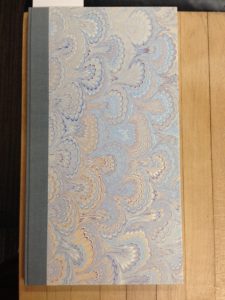What with Iris Law’s survey of chapbooks in her recent guest post for this blog, it seemed only right to feature a chapbook in the American Bookbinders Museum Library as well. A Sky Empty of Orion is the 1985 creation of noted American poet Laura Jensen, and serves as an excerpt or preview of a subsequent larger work, Shelter (1985).
While I cannot speak to the skill of the poet – she appears to be well-respected, with comparisons to Rainer Maria Rilke – I can attest to the beauty of the chapbook. With the atypical dimensions of 10.25 inches tall by 5.5 inches wide, it is a striking volume from the first glance. The binding is made from a combination of a cloth spine, Ingres Antique endpapers, and a truly lovely marbled paper by Peggy Skycraft in a bouquet marbled pattern in soft tones of pale gold, purple, blue, and cream.
Rather unusually for a chapbook, A Sky Empty of Orion is hardcover with sewn signatures. Nearly every definition of a chapbook includes a description of paperback pamphlets, usually saddle-bound or perfect-bound.
Time-out for definitions:
Saddle-bound: Binding by saddle stitching, which is a fancy way of saying it’s a pamphlet secured by staples. The term “saddle” comes from the saddle of the machine, which is the part on which the pages are placed to be brought under the stitcher.
Perfect binding (also called adhesive binding): A method of securing loose leaves into a solid text block by means of an adhesive rather than sewing or stitching. There are various types of perfect bindings, but the most common is the average paperback book seen today.
As Iris mentioned in her post on chapbooks, the format developed centuries ago, and was usually included in the wares of itinerant peddlers. Chapbooks were in their heyday in the 17th and 18th centuries, as printing and literacy expanded dramatically, and the demand for reading material reached a fever pitch. Initially, chapbooks contained all sorts of information, from literature to science to weather predictions.
The Industrial Revolution hit the chapbook and the peddlers, known as “chapmen,” hard. The chapmen were more or less driven out of business, and the rise of industrial book production and the novel resulted in a drastic drop in interest in chapbooks. It seems they clung to life, but only just.
In the 20th century, however, the chapbook revived and reshaped itself into the form we now know. It is primarily used for poetry, it is usually a short paperback or pamphlet of one or two signatures, and is sometimes a teaser of a larger work to come. Some are inexpensively produced and not designed for longevity, while others, like Jensen’s A Sky Empty of Orion, are art pieces destined to be treasured and admired.
References:
Harris, Peter. “A Shelter, A Kingdom, A Half Promised Land: Three Poets in Mid-Career,” in VQR: A National Journal of Literature and Discussion, Summer 1987. <http://www.vqronline.org/essay/shelter-kingdom-half-promised-land-three-poets-mid-career>
Jensen, Laura. A Sky Empty of Orion, (San Francisco: Meadow Press, 1985).
Law, Iris A. “Four Beautiful Chapbooks by Asian American Poets to Read During National Poetry Month,” at bookbindersmuseum.com. <http://bookbindersmuseum.org/four-beautiful-chapbooks-by-asian-american-poets-to-read-during-national-poetry-month/>
Riedel, Sam. “Chapbooks: A Short History of the Short Book,” at thethepoetry.com. <http://www.thethepoetry.com/2012/02/chapbooks-a-short-history-of-the-short-book/>
Roberts, Matt T. and Don Etherington. Bookbinding and the Conservation of Books: A Dictionary of Descriptive Terminology, (Washington: Library of Congress, 1982).


